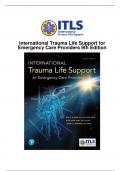Exam (elaborations)
International Trauma Life Support for Emergency Care Providers 9th Edition Table of Content
- Course
- Institution
International Trauma Life Support for Emergency Care Providers 9th Edition Table of Contents SECTION 1 Essential Information CHAPTER 1 Introduction to Traumatic Disease 1 Chapter Overview 2 Situational Awareness 2 Case Presentation 3 Scene Size-up 4 Standard Precautions 4 Scene Safety 4 T...
[Show more]



